“The wailing sound dies but slowly in my ears…”
One can imagine the scene- two Federal surgeons sit tiredly at a camp fire. It is Wednesday, September 24, 1862. The two exhausted men are in a regimental camp on Bolivar
Heights overlooking Harper’s Ferry. A mere week before, the Battle of Antietam,
the bloodiest single day of the Civil War, had been fought just a few
miles from where these two, surgeons of the 8th
Ohio Volunteer Infantry, now rested around the camp fire. Both
surgeons, Thomas McEbright and Samuel Sexton, sat and wrote, searching for the words to explain to the
folks back home what they had just lived through. It was a horror.
 |
| Looking across the Potomac River into Maryland from Harper's Ferry- one of the most picturesque and historic spots in America. |
“After some five days
of excessive toil and professional labor with a back nearly broken
from continued stooping, I take this first respite from my duties
since the battle of last Wednesday near Sharpsburg to report you my
version of the mastery as it occurred on that part of the field of
carnage and death in our immediate point,” Surgeon Thomas
McEbright wrote to editor James Estill of the Holmes
County Farmer located in Millersburg, Ohio.
“It was a victory, though dearly purchased, and by it I think the
Union saved, and there are those still in the land imposed with the
spirit of the revolutionary heroes.”
The 8th
Ohio Infantry formed a part of Brigadier General Nathan Kimball’s
Gibraltar Brigade, the brigade earning that sobriquet at Antietam
from Second Corps commander General Edwin Vose Sumner for (as
reported by Lieutenant Colonel Franklin Sawyer who commanded the
regiment at Antietam) having “taken and held one of the most
important positions on the field and had maintained an unwavering
line during the carnage of the four hours’ battle.” The brigade
had fought against the entrenched Confederates along the Sunken Road
and suffered tremendously- the 8th
Ohio went into action with 17 officers and 324 men and suffered 165
casualties, a casualty rate of 48.6%. (Colonel Sawyer reported two
officers killed, seven wounded, 30 enlisted men killed, 122 wounded,
and five missing).
 |
| 8th O.V.I. Monument at Antietam |
“The generals all compliment the gallant conduct
of the 8th, and I
am certainly proud to be a member of it and share in their praise,”
wrote Colonel Sawyer. “The carnage was awful, piles of dead, acres
of wounded everywhere met the eye. During the engagement, 17 balls
passed through our flag but it was kept waving proudly the whole
time.” The following morning, Captain Benjamin F. Ogle of Company A
walked the field where the 8th
Ohio had fought and reported finding “three distinct lines of dead
rebels lying in a little ten acre field. I counted on this field 250
dead Rebels, 30 horses, and 12 smashed cannon.”
 |
| Sunken Road aftermath by James Hope |
This deluge of casualties
quickly swamped the regimental hospital which had been set up by
Surgeon McEbright in the
Roulette family barn just behind the lines. McEbright
wrote, “The houses and barns of the neighborhood filled with scenes
of horror and suffering that would appall the most hardened in the
shedding of blood. At the Roulette barn, where I had my operative
depot, oh what a scene of misery! Here were mingled the lacerated and
maimed from all parts of the world mingling their plaintive cries and
dying groans. Braves from the lakes and mountains of Northern climes
as from the magnolia scented cottages of the sunny South.
The Rebels
especially were objects of my especial commiseration. The extreme
wounded were those generally obtained by us, and their dirty haggard
appearance, aside from their mangled limbs and contused bodies, is
not the most pleasant to look upon. (For I do not exaggerate when I
say that the Secesh army as a whole is the filthiest set of beings in
appearance (raw Indians and Mexicans not excepted) the world ever
saw.
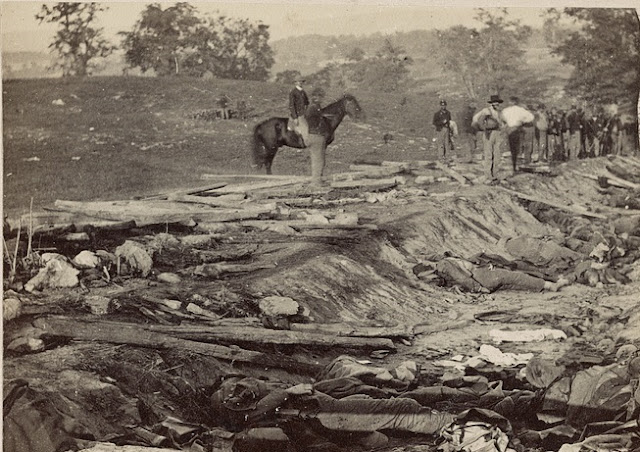 |
| Confederate dead along the Sunken Road by Alexander Gardner. Surgeon McEbright remembered that the Confederates were "as a whole the filthiest set of beings the world ever saw." |
The cry was doctor here and everywhere help implored. The
wailing sound dies but slowly in my ears and my dreams are oft
disturbed by the revisions of the sights which make even victory
sad.” (Check out John Banks' Civil War blog for some nice modern shots and video of the Roulette Farm, including the barn where the 8th Ohio surgeons set up their field hospital. http://john-banks.blogspot.com/2011/10/antietam-visit-roulette-farm-videophoto.html)
Assistant Surgeon Samuel
Sexton had also been horrified by what he saw at Antietam, but it
wasn’t just the horrors of combat- it was the malpractice of the
civilian volunteer surgeons that incurred his ire. So Sexton sent his
letter to a newspaper which enjoyed wide circulation throughout the
Midwest- the Cincinnati Daily Commercial.
“Perhaps no more proper occasion will occur during the war for a
reference to what is best for our friends at home to do in the event
of another great battle,” he wrote.
“After the engagement of the
17th, citizens
began to arrive on the ground daily until the present writing. Many
were curious to see a battlefield, others had friends or relatives
wounded or killed. Many came as volunteer surgeons and nurses.
Various Christian Commissions came with their useful supplies. And
here let me say that if it had not been for the latter, untold
suffering would have occurred.”
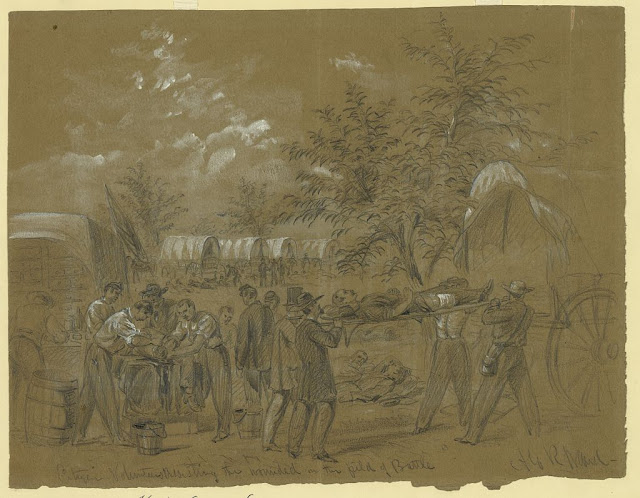 |
| Citizens help move the wounded in a sketch by Alfred Waud |
“Of the volunteer
surgeons I have one word. They mostly came with a case of amputating
instruments displayed in their hands, and paid no attention whatever
to the suffering soldier. Their only inquiry was for “operations.”
Any unfortunate soldier who happened to be carried to the army
hospital away from his division or any luckless Confederate who
possessed a shattered limb was sure to receive an anxious examination
from the first class operating surgeon, and if there existed any
excuse he was soon dismembered secundem artem.
These cases, after amputation, were always left to some kind medical
officer for after attention which is always the most important labor
connected therewith. These professional gentlemen paid no attention,
as I before remarked, to the wounded soldier’s actual wants, but
when done cutting were not again to be found. It is but just to say
that there were noble exceptions, but they were very few.”
“Medical aid after a
great battle of greatly demanded, but those who come should expect
ceaseless labor for weeks, hard fare, and much minor surgery. The
supplies most needed are clothing, surgical appliances, and
restoratives as it is impossible for the surgeon to find
transportation for when in the field. Woolen shirts and drawers are
invaluable, for when the wounded soldier is carried to the field
depot, his clothes are often torn in pieces and saturated with blood.
Wine, whiskey, and brandy are always needed, not only to relive
faintness and exhaustion, but after wounds commence suppurating, they
are largely required to keep up the powers of life.”
“But perhaps the most
desirable article that I could mention would be wire splints. They
can be applied immediately after the receipt of the injury, and thus
save the wounded much suffering from the frequent moving they
necessarily subjected to. These splints are the best because they can
be readily cleaned, and they allow a free circulation of air and the
escape of the water used in dressing. They have been found by
experience in military surgery to be the best in use. Our friends in
Ohio can rest assured that everything is being done for their wounded
soldiers that is possible under the circumstances.”
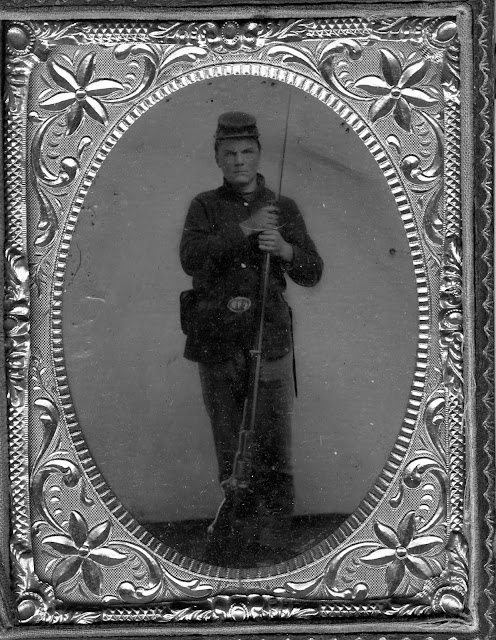
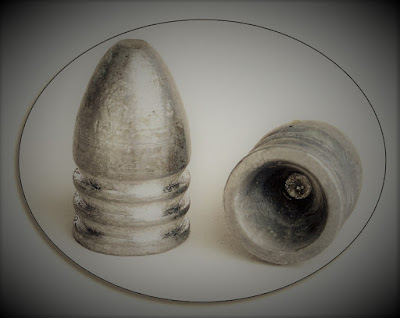




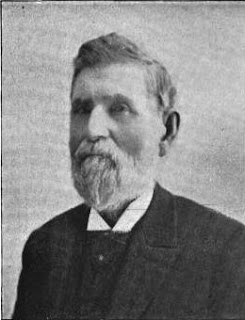


Comments
Post a Comment